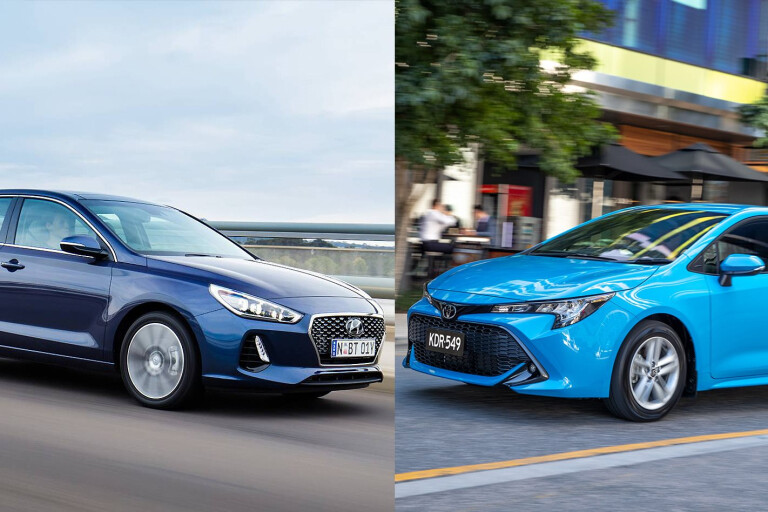
The small hatch class continues to be a major battleground in the new car sales landscape, and two of the biggest combatants are the Hyundai i30 and Toyota Corolla. We take a look at the on-paper proposition of the mid-range i30 Elite and Corolla SX variants, but distinguishing a clear winner of the two proves to be a difficult exercise.
VALUE
Hyundai’s recently-refreshed i30 Elite petrol comes with an auto as standard and retails at $27,790 before on-road costs. It sits roughly in the middle of the i30 range as a comparatively feature-rich offering, but without the additional glitter of the range-topping Premium grade or the sheer performance of the i30 N hot hatch flagship. It sits comfortably in the middle ground.
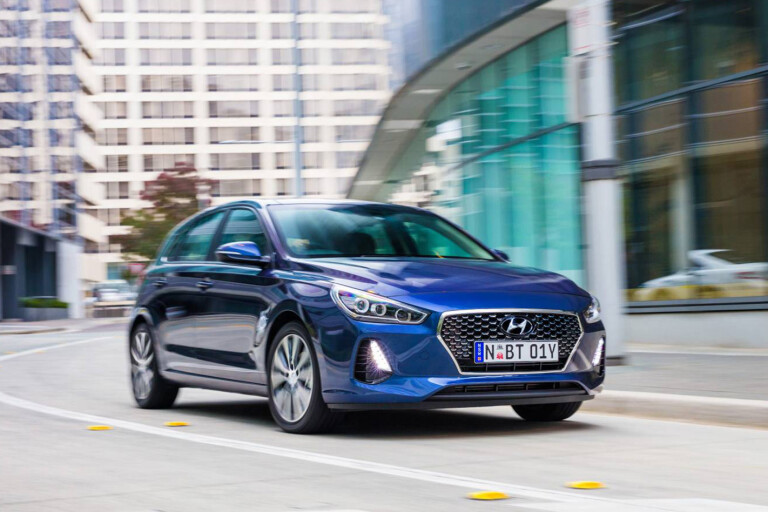
It’s fresh-faced competitor from Japan adopts a similar posture. The SX grade is smack in the middle of the Corolla’s three-variant lineup, and is available in hybrid or pure petrol form, with an automatic also standard-issue. In the petrol-powered guise we’re looking at here, it retails at a very reasonable $26,870, which gives it a $900 advantage over the Hyundai.
Or does it? The i30 comes with a five-year, unlimited kilometre factory warranty while the Corolla is covered only for the first three years or 100,000km of ownership. The difference in after-sales care could make the difference between one being considered good value or not.
SIZE
There’s not a whole lot separating the i30 and Corolla in terms of physical dimensions. The Hyundai measures in at 4340mm long, 1795mm wide and 1455mm tall, and it sits across a 2650mm long wheelbase. Compared with its Japanese competitor it’s a few centimetres shorter overall, fractionally wider and a couple of centimetres taller. Its wheelbase is also a centimetre longer.
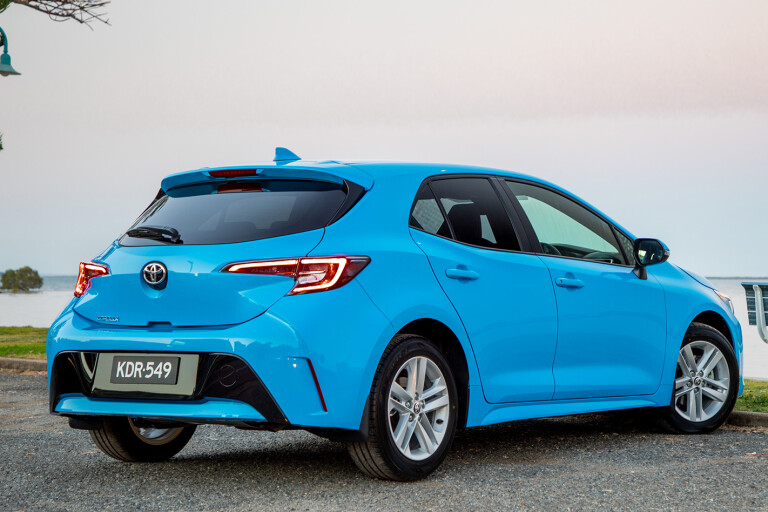
But while the external differences are marginal, it’s a different story on the inside. Here, the Corolla is shown up by the i30 in rear seat legroom and boot capacity. The latter figures are especially disparate, with the i30 offering up a generous 395 litres of luggage space compared to the Corolla’s puny 217 litres. Why is the Corolla so far behind? Because of its full-size spare tyre, which pushes up the boot floor and leaves only a shallow space for you to put your cargo.
STANDARD FEATURES
The feature set of both the Corolla SX and i30 Elite are surprisingly close. Common between the two are things like digital radio, an eight-inch colour touchscreen, keyless entry and engine start, wireless phone charging, dual-zone climate control, built-in satellite navigation and an electric park brake.
So all of the basics are well covered – and then some – but the i30 goes a little further by making rear cabin air vents standard – something you don’t get in the Corolla unless you spend big on the top-grade ZR variant. The i30 also boasts smartphone mirroring via Android Auto and Apple CarPlay, bringing some internet-enabled functionality to its infotainment system. That feature simply isn’t available on any Corolla right now.
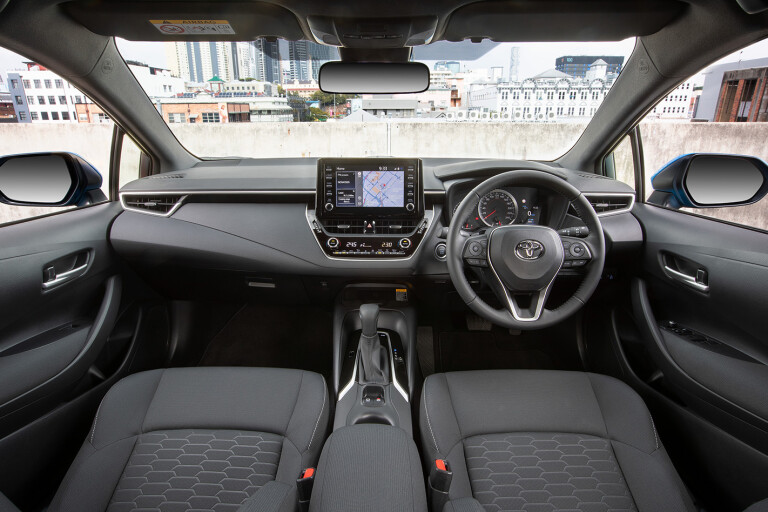
SAFETY
Both i30 and Corolla offer plenty of electronic safety aids, with blind spot monitoring, a reversing camera, lane departure control, lane keep assist and a forward collision warning being standard. That’s on top of the usual active safety gear including traction control, stability control, ABS, brake assist and seven airbags.
The i30 and Corolla both also come fitted with autonomous emergency braking as standard, but the Corolla’s system is capable of detecting both cyclists and pedestrians as well as cars. The i30, meanwhile, is only able to detect cars and pedestrians. Then again, the i30 Elite features rear parking sensors as standard, something which the Corolla doesn’t offer.
COMFORT
Front seat comfort is difficult to fault in either car. The i30 benefits from standard-issue leather upholstery which adds a premium touch, but by the same token the Corolla’s classy cloth interior certainly doesn’t feel downmarket.
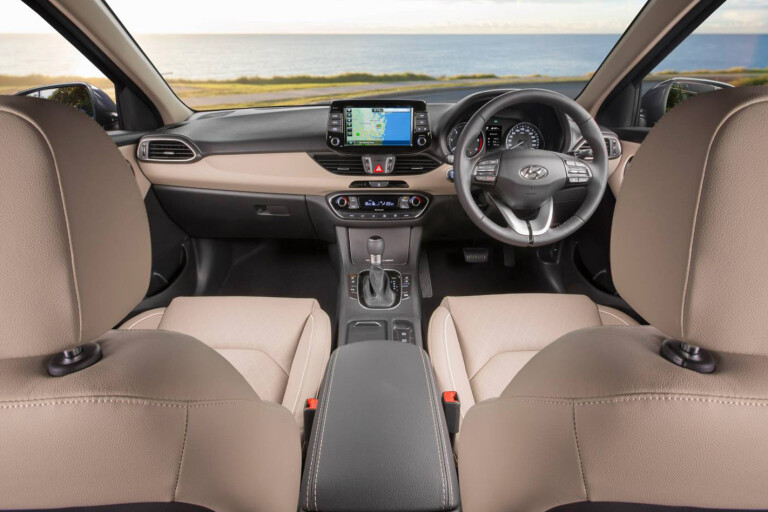
Ergonomically, both cars follow a similar format. A high-mounted ‘tombstone’ infotainment display sits at the centre of the dash, with air vents and ventilation controls immediately below it. A small storage tray at the front of the centre console houses a wireless charging pad in both, but the Corolla has a less cluttered console thanks to its electric park brake.
The real differences become apparent behind the front seats, and it’s here where the i30 steals a lead thanks to more generous legroom and headroom. It also boasts air vents on the back of the centre console to help keep backseaters cool or warm, something that’s only available on the high-grade Corolla ZR, not the mid-spec SX.
PERFORMANCE
The Corolla has a power advantage over the Hyundai, though it’s a marginal one. With 125kW and 200Nm coming from its 2.0-litre naturally-aspirated petrol inline four, the Corolla is 5kW ahead and just 3Nm behind its Korean rival in power and torque. The i30 weighs 22kg more than the Toyota as well, which gives the Corolla only a slight lead in the performance stakes.
The two cars differ more meaningfully in the drivetrain department, with the Hyundai taking power to its front wheels via a six-speed conventional automatic gearbox and the Corolla instead employing a continuously-variable transmission (CVT). The Corolla’s CVT auto differs from previous CVTs by offering a mechanical launch gear and torque converter, which removes the sluggish, rubber-band feel that traditionally impacts that type of transmission.
FUEL ECONOMY
Hyundai claims the i30 Elite petrol consumes 7.4L of fuel per 100km on the combined cycle, which makes it considerably thirstier than the Corolla, which manages to travel the same distance on just 6.0 litres of 91-octane.
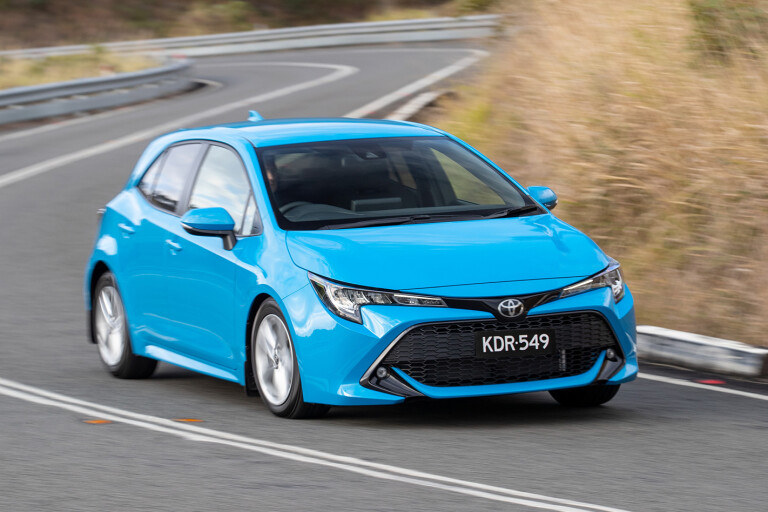
Credit that to the Corolla’s engine, which is – according to Toyota – the world’s most thermally-efficient production car powerplant. Thanks to direct injection, variable cam timing on both inlet and exhaust and a range of low-friction features, the Corolla’s naturally-aspirated 2.0 litre is able to extract 40 percent of the energy contained in the petrol it burns – a commendable figure.
VERDICT
These two cars are incredibly closely stacked in terms of their price, features and mechanicals. The real separation only becomes apparent when you home in on details like after-sales care, rear seat comfort, cargo space and fuel efficiency.
It may sound like a cop-out, but there’s no clear winner in this pairing and the victor will only become apparent once you apply your own specific criteria to these cars. Need a big boot or frequently carry more than one passenger? The i30 takes the lead. Is fuel efficiency more important? Perhaps look in the Toyota’s direction then. Both are capable, well-equipped and affordable options in their class, so you’re not losing with either of them.
COMMENTS